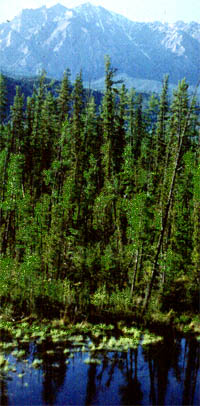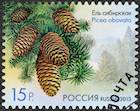
Picea obovata forest, Pinus pumila on slopes behind, Barguzimsky Natural Reserve near Baikal [Nikolai Nikolaevich Laschinskii, The Central Siberian Botanical Garden].

Pinus pumila on the slopes and Picea obovata in the valley, Barguzimsky Natural Reserve near Baikal [Nikolai Nikolaevich Laschinskii, The Central Siberian Botanical Garden].

Picea obovata with Betula sp. in Barguzimsky Natural Reserve near Baikal [Nikolai Nikolaevich Laschinskii, The Central Siberian Botanical Garden].

Illustration from Lebedour (1834).

Stand at Dolon-Uran Ridge, north of Lake Baikal [Vladimir Dinets] (e-mail 2000.02.02).
Many of the records on the range map at left are linked to iNaturalist observations, which are all photos.

Russian stamp, issued 2013.

Picea obovata
Ledeb. 1833
Common names
Ель сибирская [Russian]; Siberian Spruce [English]; Sibirgran [Norwegian].
Taxonomic notes
Both Ran et al. (2006) and Lockwood et al. (2013), in their molecular phylogenies of Picea, concur in placing P. obovata very near to P. abies in a clade primarily composed of east Asian quadrangular-needled spruces. The close relationship to P. abies has long been recognized, with some authorities reducing P. obovata to the status of a subspecies. An intermediate form, P. × fennica, represents an introgressive hybrid between the two species (Farjon 1990). This introgression is detailed by Krutovskii and Bergmann (1995), who analyzed isozyme loci for populations sampled from across the range of the two species. They found so little variation between the two taxa, and such a large zone of introgressive hybridization (covering both sides of the Ural Mountains) as to warrant describing them as "two geographical races of one spruce species." However, the molecular phylogenies indicate that P. obovata is as distinct from P. abies as other taxa in the clade such as P. meyeri or P. koyamae. A molecular clock proposed by Lockwood et al. (2013) suggests an early Pleistocene age for divergence of these species.
Synonymy:
- P. abies ssp. obovata (Ledeb.) Hultén;
- P. excelsa var. altaica Tepl.;
- P. obovata var. coerulea Tigerstedt;
- P. o. var. argentea Luchnik;
- P. o. var. krylovii Luchnik;
- P. o. var. lucifera Luchnik;
- P. o. var. lutescens Luchnik;
- P. o. var. pendula Luchnik;
- P. o. var. seminskiensis Luchnik;
- P. o. var. tschiketamanica Luchnik.
Description
Trees to 40 m tall and 100 cm dbh, typically with a single round straight trunk and a pyramidal to narrowly conical crown. Bark on larger trees gray, rough, scaly, breaking into small plates. Twigs slender, bright orange or red-brown, fading with age to gray, ridged and grooved, glabrous or sparsely pubescent; pulvini small (1 mm). Vegetative buds ovoid-conical, 4-5 × 3-4 mm, not or slightly resinous. Leaves spreading radially around shoot, directed forward, parting below, 8-25 × 1-1.8 mm, linear, straight or curved, quadrangular in cross-section, apex acute, with 2-4 lines of stomata on each face; leaves dark green. Pollen cones in leaf axils, near end of shoots, 10-15 mm long, yellow. Seed cones terminal, erect but becoming pendulous at maturity, cylindrical, 4-8 cm × 2.5-4 cm when open; green or red, maturing to brown or dark brown. Seed scales obovate-oblong to flabellate, 1.5-2.5 × 1-2 cm at mid-cone; surface smooth; upper margin obtuse or rounded, entire. Bracts rudimentary, fully included. Seeds ovoid-oblong, 2-4 mm long, dark brown with a 10-15 mm long light brown wing (Farjon 2010).
Distribution and Ecology
Russia and Mongolia: continuous with P. abies in the west, the division and zone of introgression occurring in the Ural Mountains, with P. obovata extending east from the Urals to the Sea of Okhotsk (Farjon 1990). It is a widespread tree of the taiga, where it tends to dominate on shallow soils over permafrost and occurs far northwards, to well within the Arctic Circle. In the southern parts of its range it forms almost pure forests, or is mixed with Abies sibirica in the Altai Mountains at elevations of up to 2000 m. In boggy areas it becomes a stunted, narrowly columnar tree and often grows with Larix gmelinii (a situation very reminiscent of that shared by Picea mariana and Larix laricina in the North America). Common hardwood associates include Betula spp. and Populus spp., particularly on deeper and better drained soils. In drier settings it may grow with Pinus sylvestris (Farjon 2010).
Distribution data for P. obovata and P. × fennica from GBIF (2020).
Hardy to Zone 1 (cold hardiness limit below -45.6°C) (Bannister and Neuner 2001, variety not specified), which makes it one of the most cold-hardy trees known.
Remarkable Specimens
A tree 42 m tall with a 150 cm dbh is reported on the Svyatoi Nos Peninsula, Lake Baikal, Russia. For P. × fennica: Valaam Island, Ladoga Lake, Russia (40 m tall, dbh 2.4 m) (Vladimir Dinets e-mail 1998.01.02).
The oldest known living specimen, 457 years, was documented in a tree-ring chronology covering the period 1551-2007 (crossdated after 1553), collected near at the confluence of the Indylyun River and the Lena River in Russia; the site is in a very old stand of mixed Larix gmelinii and Picea obovata, with minimal evidence of human disturbance. Collection was by Andrea Lloyd and colleagues (doi.org/10.25921/nab7-ff56).
Ethnobotany
This is a commercially important timber species and represents the largest resource of standing timber by volume in Russia; as such it is one of the world's most commercially significant conifers. Much of the wood is processed to pulp, but other uses for which Picea wood is traditionally valued also apply to P. obovata, such as the sounding boards of stringed instruments (including pianos). Outside of Russia and eastern Europe, it is seldom encountered in horticulture (Farjon 2010).
Observations
Remarks
The epithet describes the shape of the seed cone scales.
Citations
Farjon, Aljos. 1990. Pinaceae: drawings and descriptions of the genera Abies, Cedrus, Pseudolarix, Keteleeria, Nothotsuga, Tsuga, Cathaya, Pseudotsuga, Larix and Picea. Königstein: Koeltz Scientific Books.
Krutovskii, K.V. and F. Bergmann. 1995. Introgressive hybridization and phylogenetic relationships between Norway, Picea abies (L.) Karst., and Siberian, P. obovata Ledeb., spruce species studied by isozyme loci. Heredity 74: 464-480. Available: http://www.nature.com/hdy/journal/v74/n5/pdf/hdy199567a.pdf, accessed 2008.09.18.
Ledebour, C. F. von. 1833. Flora Altaica, Vol. IV-V. Berlin (p. 201).
Ledebour, C. F. von. 1834. Icones plantarum novarum vel imperfecte cognitarum floram Rossicam, imprimis Altaicam, illustrantes, Vol. V. Available at Botanicus.org.
Lockwood, Jared D., Jelena M. Aleksic, Jiabin Zou, Jing Wang, Jianquan Liu, and Susanne S. Renner. 2013. A new phylogeny for the genus Picea from plastid, mitochondrial, and nuclear sequences. Molecular Phylogenetics and Evolution 69:717-727.
See also
Elwes and Henry 1906-1913 at the Biodiversity Heritage Library. This series of volumes, privately printed, provides some of the most engaging descriptions of conifers ever published. Although they only treat species cultivated in the U.K. and Ireland, and the taxonomy is a bit dated, still these accounts are thorough, treating such topics as species description, range, varieties, exceptionally old or tall specimens, remarkable trees, and cultivation. Despite being over a century old, they are generally accurate, and are illustrated with some remarkable photographs and lithographs.






